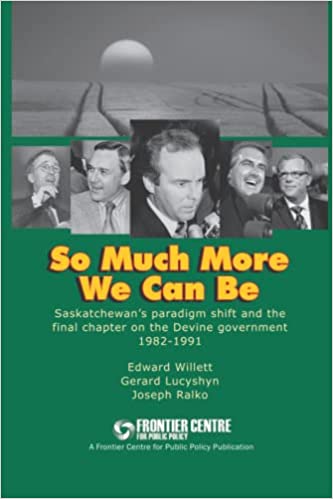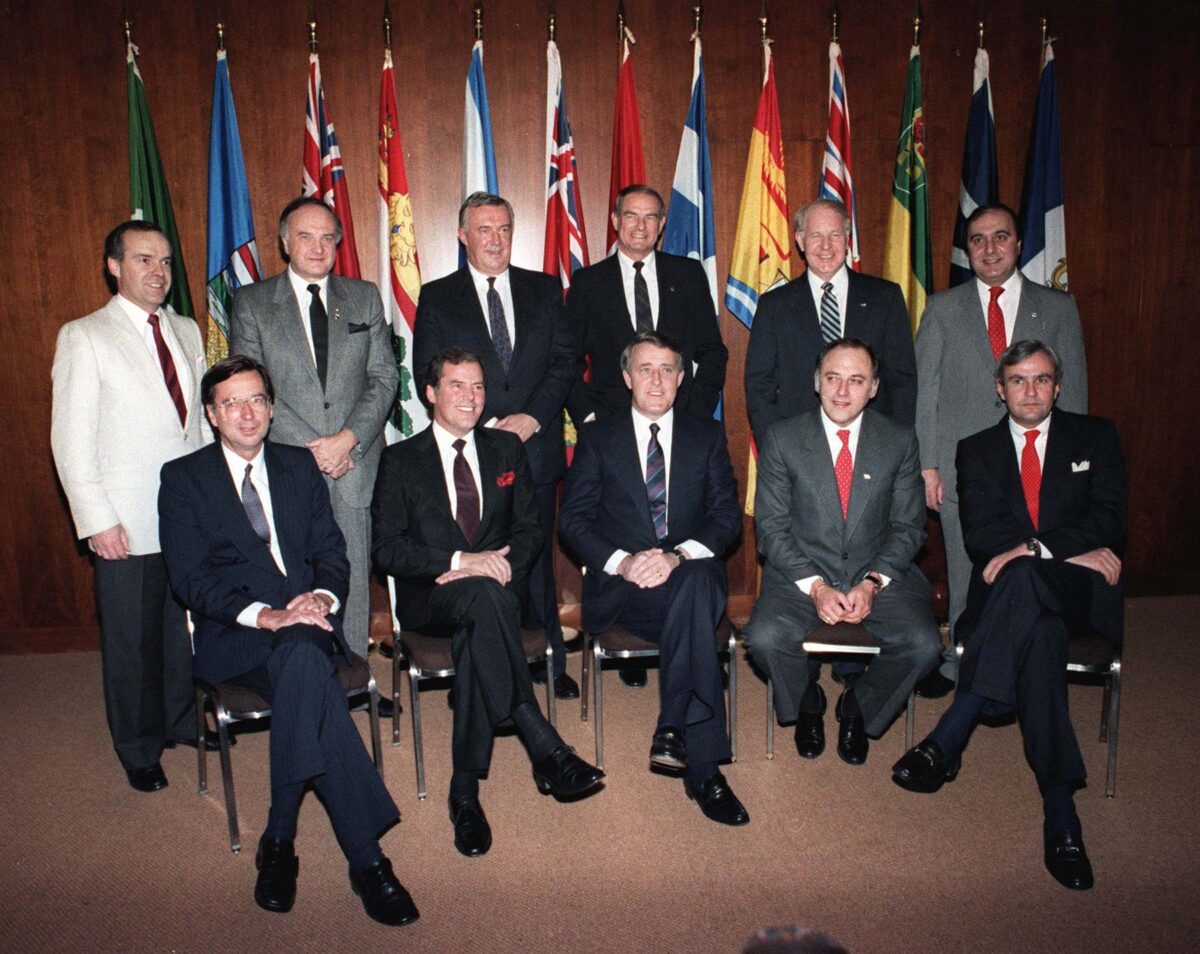Grant Devine Transformed Saskatchewan Politics
Book ExcerptWith the agriculture prices being driven up during the 1970s due to the global scare that the world was going to suffer an impending food shortage, governments rushed to flood the market with more food. This sudden increase in production caused excess supply as a result of bad public policy programs encouraging continued oversupply. When an industry is owned and operated by a government where that industry employs hundreds of people, there always is an incentive for government to continue to operate and produce excess supply, which in turn ensures steady employment (for political reasons more so than economic). This misguided public policy skews the market and drives prices down, resulting in greater losses. Under private ownership, the producer would identify excess supply (or lack of demand) as soon as the prices began to decline (and inventories began to accumulate), and cut back its production and labour force. Unemployed workers would seek employment in other industries that require an increase in production. Saskatchewan’s rationale regarding economic diversification worked on the simple notion of “do not place all your eggs in one basket.” However, if thinking on a more informed economic basis about how markets work, interact, and the effect in the long-run and not just for the immediate future, a more fulsome economic strategy is required. Grant Devine was the 11th premier of Saskatchewan, his term lasting from May 8, 1982 to Nov. 1, 1991. Upon reviewing, with 20/20 hindsight, the economic conditions during the pre-Devine period (1973–1982), the Devine era (1982–1991), and the post-Devine period (1991–2000), it is quite evident that the Devine era was marked with multiple economic challenges largely due to external market forces, and following a diversification plan that, while capitalizing on the rich primary resources Saskatchewan is endowed with, continued to leave Saskatchewan susceptible to economic commodity cycles. However, we do see quite clearly that the geometric mean return of three large Crown corporations was significantly higher after the Devine government privatized them. Despite the rather poor performing industries during the Devine era, the rates of return were clearly better than the market and the bond rates. In addition, these firms have become world leaders within their own sectors: Cameco is the largest publicly traded uranium company in the world and the second-largest uranium producer in the world, while Potash Corporation of Saskatchewan, which merged with Agrium to form Nutrien, is the world’s largest producer of potash and second-largest producer of nitrogen fertilizer. The Saskatchewan Oil and Gas Corporation, after being privatized in 1986, would continue to operate as Wascana Energy until 1997 when it was purchased by Canadian Occidental Petroleum. Canadian Occidental Petroleum would be eventually purchased by Nexen, a Canadian oil and gas company based in Calgary. Nexen would become a wholly owned subsidiary of China National Offshore Oil Corporation, a Hong Kong based state-owned oil and gas company which is the third largest of the Chinese oil companies. All of these Crown corporations after being privatized would contribute substantial tax revenues to the province in the future. As the commodity cycles for uranium, potash, and oil turned around, these companies and shareholders would find themselves in great positions to capitalize on the upswing in the commodity cycle. When considering economic data of the three different time periods—the pre-Devine period, the Devine era, and the post-Devine period—and the performance of the global economy and the effect world markets had on Saskatchewan’s primary resource sector, it is evident that broader, global economic forces during the Devine era worked to undermine a newly elected government, whose efforts focused on making a systemic change from public-owned production to privately owned production. The glut of supply on the international markets leading up to the Devine era further indicates the effects of publicly owned and controlled supply, as governments and countries around the world rushed into production having perceived the opportunity to prop up their exports and employment. In the end, the numbers demonstrate quite clearly that the Devine government’s initiation to turn a province that was largely unknown in the world into world-class leaders in mining and agriculture was a success. Over the years, many people remember the Devine period either as a success, a failure, or the best that could be expected under very challenging circumstances. However, to measure Devine’s legacy one needs to assess how the province has progressed and grown since then. Did the accomplishments outweigh the mistakes? Did the accomplishments have a positive effect on the province’s future? Saskatchewan today continues to depend on commodity production and is considered a “have” province. It no longer receives equ

Book Excerpt
With the agriculture prices being driven up during the 1970s due to the global scare that the world was going to suffer an impending food shortage, governments rushed to flood the market with more food. This sudden increase in production caused excess supply as a result of bad public policy programs encouraging continued oversupply.
When an industry is owned and operated by a government where that industry employs hundreds of people, there always is an incentive for government to continue to operate and produce excess supply, which in turn ensures steady employment (for political reasons more so than economic). This misguided public policy skews the market and drives prices down, resulting in greater losses. Under private ownership, the producer would identify excess supply (or lack of demand) as soon as the prices began to decline (and inventories began to accumulate), and cut back its production and labour force. Unemployed workers would seek employment in other industries that require an increase in production.
Saskatchewan’s rationale regarding economic diversification worked on the simple notion of “do not place all your eggs in one basket.” However, if thinking on a more informed economic basis about how markets work, interact, and the effect in the long-run and not just for the immediate future, a more fulsome economic strategy is required.
Grant Devine was the 11th premier of Saskatchewan, his term lasting from May 8, 1982 to Nov. 1, 1991. Upon reviewing, with 20/20 hindsight, the economic conditions during the pre-Devine period (1973–1982), the Devine era (1982–1991), and the post-Devine period (1991–2000), it is quite evident that the Devine era was marked with multiple economic challenges largely due to external market forces, and following a diversification plan that, while capitalizing on the rich primary resources Saskatchewan is endowed with, continued to leave Saskatchewan susceptible to economic commodity cycles.
However, we do see quite clearly that the geometric mean return of three large Crown corporations was significantly higher after the Devine government privatized them. Despite the rather poor performing industries during the Devine era, the rates of return were clearly better than the market and the bond rates.

In addition, these firms have become world leaders within their own sectors: Cameco is the largest publicly traded uranium company in the world and the second-largest uranium producer in the world, while Potash Corporation of Saskatchewan, which merged with Agrium to form Nutrien, is the world’s largest producer of potash and second-largest producer of nitrogen fertilizer. The Saskatchewan Oil and Gas Corporation, after being privatized in 1986, would continue to operate as Wascana Energy until 1997 when it was purchased by Canadian Occidental Petroleum. Canadian Occidental Petroleum would be eventually purchased by Nexen, a Canadian oil and gas company based in Calgary. Nexen would become a wholly owned subsidiary of China National Offshore Oil Corporation, a Hong Kong based state-owned oil and gas company which is the third largest of the Chinese oil companies.
All of these Crown corporations after being privatized would contribute substantial tax revenues to the province in the future. As the commodity cycles for uranium, potash, and oil turned around, these companies and shareholders would find themselves in great positions to capitalize on the upswing in the commodity cycle.
When considering economic data of the three different time periods—the pre-Devine period, the Devine era, and the post-Devine period—and the performance of the global economy and the effect world markets had on Saskatchewan’s primary resource sector, it is evident that broader, global economic forces during the Devine era worked to undermine a newly elected government, whose efforts focused on making a systemic change from public-owned production to privately owned production. The glut of supply on the international markets leading up to the Devine era further indicates the effects of publicly owned and controlled supply, as governments and countries around the world rushed into production having perceived the opportunity to prop up their exports and employment. In the end, the numbers demonstrate quite clearly that the Devine government’s initiation to turn a province that was largely unknown in the world into world-class leaders in mining and agriculture was a success.
Over the years, many people remember the Devine period either as a success, a failure, or the best that could be expected under very challenging circumstances. However, to measure Devine’s legacy one needs to assess how the province has progressed and grown since then. Did the accomplishments outweigh the mistakes? Did the accomplishments have a positive effect on the province’s future?
Saskatchewan today continues to depend on commodity production and is considered a “have” province. It no longer receives equalization payments from the federal government but rather contributes to other “have not” provinces.
Overall, the economy is now more diversified, with a large manufacturing sector and a multiplicity of commercial, industrial, and consumer service businesses. Agriculture-related biotech, developed in the 1980s, is a full-fledged innovation driver. The population has steadily increased, along with growing investment in the province. Saskatchewan continues to be subjected to drought as well as volatile oil, gas, and uranium prices; however, due to the province’s diversification, these things are not enough to negatively impact economic growth and employment, as they did in the past.
Most importantly, there has been a change in attitude. Saskatchewan is no longer recognized as Canada’s great socialist experiment. The Co-operative Commonwealth Federation–NDP vision of a society regulated from the top, with bureaucrats “holding the commanding heights of the economy,” was a feature of the province’s culture right up to the years of Devine’s predecessor Allan Blakeney—and it was not moderating. If the box factory, the woolen mill, the boot business, and the brick factory of the early Tommy Douglas days were gone, vast swaths of economic activity remained under government control: the potash industry, the oil industry, uranium mines, a transportation company, telephones, natural gas, electricity generation and distribution, and over a million acres of farmland.

The NDP–Blakeney regime, far from reconsidering its plans in the light of changing world conditions, campaigned in 1982 on slogans of continuing those policies. “Let’s keep a good thing going,” their ads said, and “Tested and trusted,” which prompted the Devine rejoinder that the socialist motto should be “Tired and rusted.”
Unquestionably the Devine years are a watershed—a before-and-after moment in the history of Saskatchewan. The province is no longer the plucky little loser of Confederation, Next Year Country, or the laboratory for collectivist ideas that never quite work out.
When the NDP under Roy Romanow, who succeeded Devine, were in power they showed no enthusiasm for reviving the Regina Manifesto or the dreams of enacting pure socialism; instead their governments were marked by a rightward drift with fiscal restraints, cutbacks, and privatization. There was a last-ditch burst of enthusiasm for old leftist ideas under Lorne Calvert, but these were soundly crushed by Brad Wall’s right-leaning Saskatchewan Party. The NDP, having lost the trust of suburban voters and the provincial middle class, has been in the political wilderness ever since. Grant Devine had decisively shifted the political culture.
Saskatchewan now is recognized on the global map as a leader in not only agriculture but in biotechnology, uranium, potash, pulp, natural gas, and heavy oil. The final chapter of the Grant Devine era and the legacy left behind marked the beginning, the spark, the planted seed, which reinvigorated the people of Saskatchewan and helped them to truly believe that there is so much more they could be.
Excerpt from the book “So Much More We Can Be: Saskatchewan’s paradigm shift and the final chapter on the Devine government 1982-1991,” published by the Frontier Centre for Public Policy and available at Amazon.ca. The Hon. Grant Devine will speak at a Frontier Centre lunch in Winnipeg Nov. 9. Tickets are available at Eventbrite.
Views expressed in this article are the opinions of the author and do not necessarily reflect the views of The Epoch Times.













